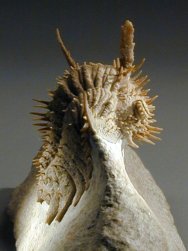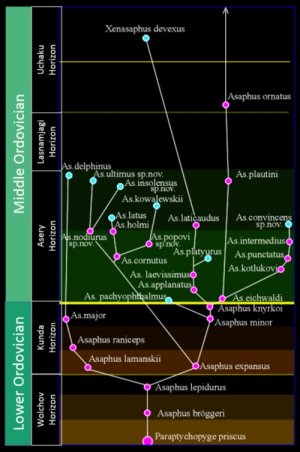about Russian Trilobites
|
about
Russian Trilobites | ||
|
|
|
|
|
The
Cambrian is one of the most sensational periods
of paleobiology on earth. An explosion of diversity and form of eukaryotic life
occurred resulting in the appearance of most major phyla of life extant to day,
as well as other phyla that appeared and disappeared. By the Ordovician (504 to
441 million years ago), the outcome of the solar energy- and floral oxygen-driven
Cambrian explosion was manifest in the still accelerating diversity of trilobites
(fewer families than in the Cambrian, but more morphologicalvariation). With 100
million years of selective pressure behind them, the trilobites from what is today
Russia developed unusual shapes, some with eyes on long stalks, and others with
jagged spines. Ultimately these magnificent animals, in whole or part, met their
demise in During the Ordovician, what is now Eastern Europe was a shallow inland sea. The fauna was rich and diverse, and included the early vertebrates. This was the heart of the age of the trilobite, a time when trilobites were not only diverse, but had undergone adaptations yielding striking morphologies. The diversity of the Russian trilobites, available across so many families and forms, the exquisite preservation in three-dimensional relief, expert preparation, affordability, and the explicit exotic expressions of nature all combine to make Russian trilobites a ubiquitous favorite of collectors. The Baltic limestone deposits that bare these trilobites was formed in seas of about 70 - 330 feet in depth in what was probably a large shallow basin. Scientists believe that this basin was repeatedly blocked from contact with the sea to the west, resulting in changes in both turbidity and salinity. Toward the end of the early Ordovician the connection was re-established, with substantial deterioration in visibility in the seas due to the influx of more turbid water. At this time some trilobites developed raised eyes perhaps to improve their vision both of potential prey as well as predators. The "periscope eyes" of Asaphus Kowalewski were not yet evident as this species evolved somewhat later. While many trilobites were detritivores feeding on animal and plant debris in the bottom muck, Asaphids are presumed to have been necrophagous, meaning that they fed on dead carcasses, due to the shape of the hypostoma (platform for mouthparts). The
remains of this ancient Ordovician fauna are abundant in the Baltic region,
and
the city of Saint Petersburg literally sets on a bed of Ordovician limestone.
Many Ordovician outcrops occur south of Saint Petersburg, and far and away
the
most prolific yield of trilobites comes from the so-called Asery horizon that
is some 20 meters thick near the Wolchov River. Some 20 genera and 100 species
are found in exquisite, non-compressed preservation. Moreover, the limestone
matrix
(in a manner similar to that of the Devonian strata in Oklahoma is relatively
soft, enabling an expert with modern preparatory equipment to produce finished
fossils that can seem life-like. The trilobite exoskeletons Asaphidae Far and away the most prevalent, and the family best exhibiting the outcome of adaptive strategies, is the family Asaphidae. Some 30 species are believed to have descended from Asaphus broggeri that is found in the Wolchovian horizon, with possibly Paraptychopyge as its sole ancestor. The figure shows the bushy branching of Asaphidae as suggested by cladistic research spanning more than a century. Asaphus lepiderus replaced Asaphus broggeri, and represents a major branching to: 1) the very similar Asaphus expansus and 2) a new genus represented by Asaphus lamanskii. Asaphus lamanskii was successively superceded by Asaphus raniceps and Asaphus major that occur in the kunda horizon, and the much later Middle Ordovician termination of the branch with Asaphus delphinus; mysteriously, no intermediate forms are known. Asaphus expansus apparently gave rise to the remainder of the Asaphus line, which itself would undergo additional and exotic diversification. Asaphus applanatus began a tendency to larger width and genal angle, such as the impressive Asaphus platyurus. Also impressive was the succession of Asaphus kotlukovi, Asaphus punctatus, Asaphus intermedius and Asaphus convincens that express progressively higher eye stalks. The same tendency of adaptation occurred in a line that includes Asaphus cornutus and Asaphus kowalewskii, among several others. The Asery layer captures some 2 million years of rapid adaptive radiation, apparently in response to environmental challenges such as a more shallow sea, increased seaweed and higher acidity. The last descendents of Asaphus disappear in the layers of the Upper Ordovician, manifest evidence that adaptation has its limits. |
|
Fossil Mall Navigation: Navigate
by Fossil Category: l Fossils and Paleotological Science Information l | ||||||


 generally are
extremely
well preserved, and are a milk-chocolate color that contrasts well against the
lighter limestone. Horizons above and below show the progenitors and descendents
of trilobites from the Asery level, adding diversity to the trilobites from
the
region, and adding to a wonderful story of decent with modification. Some dozen
trilobite families are represented, including Asaphidae, Illaenidae, Cheiruridae,
Encrinuridae, Raphiophoridea, Lichadidae, Remopleuridae, Harpedidea and Phacopidae.
generally are
extremely
well preserved, and are a milk-chocolate color that contrasts well against the
lighter limestone. Horizons above and below show the progenitors and descendents
of trilobites from the Asery level, adding diversity to the trilobites from
the
region, and adding to a wonderful story of decent with modification. Some dozen
trilobite families are represented, including Asaphidae, Illaenidae, Cheiruridae,
Encrinuridae, Raphiophoridea, Lichadidae, Remopleuridae, Harpedidea and Phacopidae.